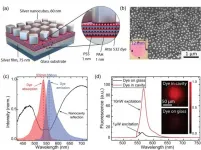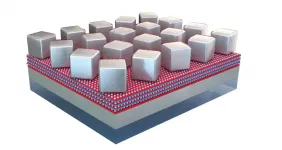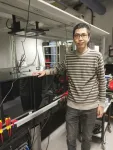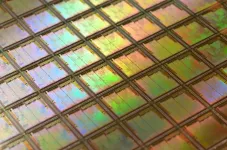(Press-News.org) Superconductors -- materials that conduct electricity without resistance -- are remarkable. They provide a macroscopic glimpse into quantum phenomena, which are usually observable only at the atomic level. Beyond their physical peculiarity, superconductors are also useful. They're found in medical imaging, quantum computers, and cameras used with telescopes.
But superconducting devices can be finicky. Often, they're expensive to manufacture and prone to err from environmental noise. That could change, thanks to research from Karl Berggren's group in the Department of Electrical Engineering and Computer Science.
The researchers are developing a superconducting nanowire, which could enable more efficient superconducting electronics. The nanowire's potential benefits derive from its simplicity, says Berggren. "At the end of the day, it's just a wire."
Berggren will present a summary of the research at this month's IEEE Solid-state Circuits Conference.
Resistance is futile
Most metals lose resistance and become superconducting at extremely low temperatures, usually just a few degrees above absolute zero. They're used to sense magnetic fields, especially in highly sensitive situations like monitoring brain activity. They also have applications in both quantum and classical computing.
Underlying many of these superconductors is a device invented in the 1960s called the Josephson junction -- essentially two superconductors separated by a thin insulator. "That's what led to conventional superconducting electronics, and then ultimately to the superconducting quantum computer," says Berggren.
However, the Josephson junction "is fundamentally quite a delicate object," Berggren adds. That translates directly into cost and complexity of manufacturing, especially for the thin insulating later. Josephson junction-based superconductors also may not play well with others: "If you try to interface it with conventional electronics, like the kinds in our phones or computers, the noise from those just swamps the Josephson junction. So, this lack of ability to control larger-scale objects is a real disadvantage when you're trying to interact with the outside world."
To overcome these disadvantages, Berggren is developing a new technology -- the superconducting nanowire -- with roots older than the Josephson junction itself.
Cryotron reboot
In 1956, MIT electrical engineer Dudley Buck published a description of a superconducting computer switch called the cryotron. The device was little more than two superconducting wires: One was straight, and the other was coiled around it. The cryotron acts as a switch, because when current flows through the coiled wire, its magnetic field reduces the current flowing through the straight wire.
At the time, the cryotron was much smaller than other types of computing switches, like vacuum tubes or transistors, and Buck thought the cryotron could become the building block of computers. But in 1959, Buck died suddenly at age 32, halting the development of the cryotron. (Since then, transistors have been scaled to microscopic sizes and today make up the core logic components of computers.)
Now, Berggren is rekindling Buck's ideas about superconducting computer switches. "The devices we're making are very much like cryotrons in that they don't require Josephson junctions," he says. He dubbed his superconducting nanowire device the nano-cryotron in tribute to Buck -- though it works a bit differently than the original cryotron.
The nano-cryotron uses heat to trigger a switch, rather than a magnetic field. In Berggren's device, current runs through a superconducting, supercooled wire called the "channel." That channel is intersected by an even smaller wire called a "choke" -- like a multilane highway intersected by a side road. When current is sent through the choke, its superconductivity breaks down and it heats up. Once that heat spreads from the choke to the main channel, it causes the main channel to also lose its superconducting state.
Berggren's group has already demonstrated proof-of-concept for the nano-cryotron's use as an electronic component. A former student of Berggren's, Adam McCaughan, developed a device that uses nano-cryotrons to add binary digits. And Berggren has successfully used nano-cryotrons as an interface between superconducting devices and classical, transistor-based electronics.
Berggren says his group's superconducting nanowire could one day complement -- or perhaps compete with -- Josephson junction-based superconducting devices. "Wires are relatively easy to make, so it may have some advantages in terms of manufacturability," he says.
He thinks the nano-cryotron could one day find a home in superconducting quantum computers and supercooled electronics for telescopes. Wires have low power dissipation, so they may also be handy for energy-hungry applications, he says. "It's probably not going to replace the transistors in your phone, but if it could replace the transistor in a server farm or data center? That would be a huge impact."
Beyond specific applications, Berggren takes a broad view of his work on superconducting nanowires. "We're doing fundamental research, here. While we're interested in applications, we're just also interested in: What are some different kinds of ways to do computing? As a society, we've really focused on semiconductors and transistors. But we want to know what else might be out there."
INFORMATION:
Initial funding for nano-cryotron research in the Berggren lab was provided by the National Science Foundation.
Written by Daniel Ackerman, MIT News Office
It is no secret that U.S. politics is polarized. An experiment conducted by MIT researchers now shows just how deeply political partisanship directly influences people's behavior within online social networks.
Deploying Twitter bots to help examine the online behavior of real people, the researchers found that the likelihood that individuals will follow other accounts on Twitter triples when there appears to be a common partisan bond involved.
"When partisanship is matched, people are three times more likely to follow other accounts back," says MIT professor David Rand, co-author of a new paper detailing the study's results. "That's a really big effect, and clear evidence of how important a role partisanship plays."
The finding helps reveal ...
A new largescale genetic analysis has found biological mechanisms that contribute to making people more susceptible to muscle weakness in later life, finding that diseases such as osteoarthritis and diabetes may play a large role in susceptibility.
As we get older we lose muscle strength, and in some people this severe weakness impacts their ability to live everyday lives, a condition called sarcopenia. Around 10 per cent of people over 50 experience sarcopenia. Many causes thought to impact likelihood of developing this weakness, which is linked to higher death rates.
In a genetic analysis of over 250,000 people aged over 60 from UK Biobank and 21 other cohorts, an international team led by researchers at the University of Exeter ...
WASHINGTON -- Researchers have created a new plasmonic metasurface that achieves record high light efficiency over the entire centimeter-scale metasurface. The advance makes the new nanostructured thin film practical for use in a variety of applications from light-based communication to fluorescence-based biosensing.
"The major obstacles for using plasmonic structures for practical applications is that they are either too inefficient or their nanoscale properties aren't easily scalable to larger sizes," said research team leader Maiken H. Mikkelsen from Duke University. "We designed ...
DURHAM, N.C. - Visible and infrared light can carry more data than radio waves, but has always been confined to a hard-wired, fiber-optic cable. Working with Facebook's Connectivity Lab, a Duke research team has now made a major advance toward the dream of ditching the fiber in fiber optics.
While working to create a free-space optical communication system for high-speed wireless internet, the researchers also show that speed and efficiency properties previously demonstrated on tiny, single-unit plasmonic antennas can also be achieved on larger, centimeter-scale devices.
The research appears online Feb. 11 in the journal Optica.
In 2016, researchers from Internet.org's Connectivity Lab--a subsidiary of Facebook--outlined a new type of light detector that could ...
A total of 1.1 million bitcoin were stolen in the 2013-2017 period. Given the current price for Bitcoin exceeding $40,000, the corresponding monetary equivalent of losses is more than $44 billion highlighting the societal impact of this criminal activity. The question arises how does the uncertainty in the Bitcoin market - measured by its volatility - respond to such cyberattacks.
A recently published research article from Dr. Klaus Grobys (University of Vaasa, Finland) in the well-known journal Quantitative Finance addresses this question.
In his study, he examined 29 hacking incidents that occurred in the Bitcoin market in the 2013-2017 period. A surprising result of this study is that Bitcoin volatility does not respond to hackings with a subsequent ...
Research from the University of Kent, Goethe-University in Frankfurt am Main, and the Philipps-University in Marburg has provided crucial insights into the biological composition of SARS-CoV-2, the cause of COVID-19, revealing vital clues for the discovery of antiviral drugs.
Researchers compared SARS-CoV-2 and the closely related virus SARS-CoV, the cause of the 2002/03 SARS outbreak. Despite being 80% biologically identical, the viruses differ in crucial properties. SARS-CoV-2 is more contagious and less deadly, with a fatality rate of 2% compared to SARS-CoV's 10%. Moreover, SARS-CoV-2 can be spread by asymptomatic individuals, whereas SARS-CoV was only transmitted by those who were already ill.
Most functions in cells are carried ...
A team of researchers studying the effectiveness of different types of face masks has found that in order to provide the best protection against COVID-19, the fit of a mask is as important, or more important, than the material it is made of.
The researchers, from the University of Cambridge, carried out a series of different fit tests, and found that when a high-performance mask - such as an N95, KN95 or FFP2 mask - is not properly fitted, it performs no better than a cloth mask. Minor differences in facial features, such as the amount of fat under the skin, make significant differences in how well a mask fits.
The results, published in the journal PLoS ONE, also suggest that the fit-check routine used in many healthcare settings has high failure rates, as minor leaks ...
Current electronic components in computers, mobile phones and many other devices are based on microstructured silicon carriers. However, this technology has almost reached its physical limits and the smallest possible structure sizes.
Two-dimensional (2D) materials are therefore being intensively researched. One can imagine these materials as extremely thin films consisting of only one layer of atoms. The best known is graphene, an atomically thin layer of graphite. For its discovery, Andre Geim and Konstantin Novoselov received the Nobel Prize in Physics in 2010.
While ...
Our world needs reliable telecommunications more than ever before. However, classic devices have limitations in terms of size and cost and, especially, power consumption - which is directly related to greenhouse emissions. Graphene could change this and transform the future of broadband. Now, Graphene Flagship researchers have devised a wafer-scale fabrication technology that, thanks to predetermined graphene single-crystal templates, allows for integration into silicon wafers, enabling automation and paving the way to large scale production.
This work, published in the prestigious journal ACS Nano, is a great example of a collaboration fostered by the ...
During the first confinement (18 March to 10 May 2020), people who reported worse sleep quality during a night also reported an increase in negative mood, psychotic-type like experiences and somatic complaints on the next day. Furthermore, daily reports of deaths caused by Covid-19 predicted psychological symptoms on the same day and sleep quality the following night. This is the result of research carried out in three countries (Belgium, Hungary, Spain) under direction of Peter Simor with researchers at the Université libre de Bruxelles (ULB), Rebeca Sifuentes-Ortega, Ariadna Albajara Saenz, Oumaïma Benkirane, Anke Van Roy and Philippe Peigneux from the CRCN (Center for Research in Cognition and Neurosciences) and the UNI (ULB Neurosciences Institute) ...




